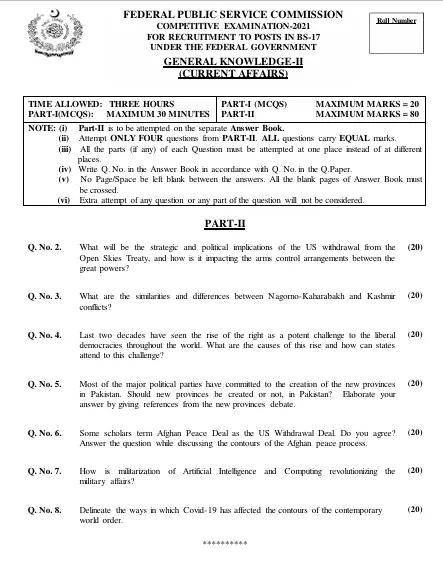Table of Contents
ToggleCSS Current Affairs Paper 2021
PART-II
Q. No. 2. What will be the strategic and political implications of the US withdrawal from the Open Skies Treaty, and how is it impacting the arms control arrangements between the great powers?(20)
Q. No. 3. What are the similarities and differences between the Nagorno-Kaharabakh and Kashmir conflicts? (20)
Q. No. 4. The last two decades have seen the rise of the right as a potent challenge to liberal democracies throughout the world. What are the causes of this rise and how can states attend to this challenge? (20)
Q. No. 5. Most of the major political parties have committed to the creation of the new provinces in Pakistan. Should new provinces be created or not, in Pakistan? Elaborate your answer by giving references from the new provinces debate. (20)
Q. No. 6. Some scholars term the Afghan Peace Deal as the US Withdrawal Deal. Do you agree? Answer the question while discussing the contours of the Afghan peace process. (20)
Q. No. 7. How is the militarization of artificial intelligence and computing revolutionizing military affairs? (20)
Q. No. 8. Delineate the ways in which Covid-19 has affected the contours of the contemporary world order. (20)
Summary:
Q. No. 2: What will be the strategic and political implications of the US withdrawal from the Open Skies Treaty, and how is it impacting the arms control arrangements between the great powers? (20)
Strategic Implications:
- Reduced Transparency: Limits verification measures, increasing mistrust between the US and Russia.
- Arms Race Risk: Lack of surveillance mechanisms may fuel military build-ups.
- Impact on Allies: NATO allies lose a key tool for monitoring Russia’s military activities.
Political Implications:
- Weakening of Treaties: Undermines confidence in other agreements, like New START.
- Shift in US Policy: Reflects unilateralism in US foreign policy under certain administrations.
Impact on Arms Control:
- Erosion of Norms: Signals decline in multilateralism for arms control.
- China’s Exclusion: Lack of Chinese participation in similar treaties may worsen dynamics.
Q. No. 3: What are the similarities and differences between the Nagorno-Karabakh and Kashmir conflicts? (20)
Similarities:
- Ethnic and Territorial Roots: Both involve ethnic groups contesting territorial control.
- Third-Party Involvement: International players influence both conflicts (e.g., Turkey in Nagorno-Karabakh, Pakistan/India in Kashmir).
- UN Involvement: Resolutions exist but lack enforcement.
Differences:
- Legal Status: Kashmir is a UN-recognized disputed territory; Nagorno-Karabakh is internationally acknowledged as Azerbaijani territory.
- Nature of Conflict: Kashmir involves insurgency and state oppression, while Nagorno-Karabakh has seen open warfare.
- International Focus: Kashmir garners sustained global attention; Nagorno-Karabakh has episodic visibility.
Q. No. 4: The last two decades have seen the rise of the right as a potent challenge to liberal democracies throughout the world. What are the causes of this rise, and how can states attend to this challenge? (20)
Causes:
- Economic Disparities: Globalization-induced inequalities fuel populism.
- Cultural Backlash: Perceived threats to national identity drive support for right-wing ideologies.
- Distrust in Institutions: Corruption and inefficiency undermine trust in liberal democratic systems.
- Technological Influence: Social media amplifies divisive rhetoric.
Responses:
- Inclusive Policies: Address economic grievances through equitable reforms.
- Civic Education: Promote awareness of democratic values.
- Regulating Media: Combat misinformation without undermining free speech.
- Strengthening Institutions: Build trust through transparent governance.
Q. No. 5: Most of the major political parties have committed to the creation of the new provinces in Pakistan. Should new provinces be created or not? Elaborate your answer by giving references from the new provinces debate. (20)
Arguments for New Provinces:
- Administrative Efficiency: Smaller units improve governance and service delivery.
- Representation: Addresses grievances of marginalized regions (e.g., South Punjab).
- Economic Development: Decentralized control fosters regional growth.
Arguments Against:
- Ethnic Tensions: Risk of inflaming ethnic and linguistic divides.
- Resource Allocation: Adds strain to federal resources and disputes.
- Political Manipulation: Risk of gerrymandering for electoral gains.
Balanced Approach: Adopt a gradual and consensus-based process ensuring inclusivity and sustainability.
Q. No. 6: Some scholars term the Afghan Peace Deal as the US Withdrawal Deal. Do you agree? Answer the question while discussing the contours of the Afghan peace process. (20)
Contours of the Peace Process:
- US-Taliban Agreement: Focused on US troop withdrawal in exchange for Taliban’s non-support of terrorism.
- Intra-Afghan Dialogue: Emphasized, but lacked significant progress.
- Conditions-Based Withdrawal: Rarely enforced.
Agreement as a Withdrawal Deal:
- The focus on troop withdrawal over sustainable peace suggests prioritization of US exit.
- Limited guarantees on long-term stability or protection of Afghan government institutions.
Consequences: Resurgence of Taliban control and regional instability underscores the deal’s shortcomings.
Q. No. 7: How is the militarization of artificial intelligence and computing revolutionizing military affairs? (20)
Advancements in Military Affairs:
- Autonomous Weapons: AI-powered drones and robots reduce human involvement.
- Cyber Warfare: Sophisticated AI-driven attacks target critical infrastructure.
- Predictive Analytics: Machine learning enhances intelligence and decision-making.
- Enhanced Defense Systems: AI optimizes missile defense and surveillance.
Implications:
- Ethical Concerns: Issues of accountability in autonomous weapon use.
- Arms Race: Increases global competition in advanced military technologies.
- Reduced Human Casualties: While minimizing direct combat, risks collateral damage.
Future Directions: Developing global regulations for ethical AI deployment in military contexts.
Q. No. 8: Delineate the ways in which Covid-19 has affected the contours of the contemporary world order. (20)
Economic Impacts:
- Global Recession: Disrupted supply chains and slowed economic growth.
- Debt Accumulation: Developing countries faced increased financial crises.
Geopolitical Impacts:
- US-China Rivalry: Accelerated as both blame each other for pandemic management.
- Rise of Regionalism: Countries prioritize regional over global supply chains.
Social Impacts:
- Inequality: Widened gaps between wealthy and poor nations.
- Global Cooperation: Weakness in WHO and multilateral institutions.
Conclusion: COVID-19 has emphasized the fragility of globalism, underscoring the need for resilient and cooperative frameworks in the future.
